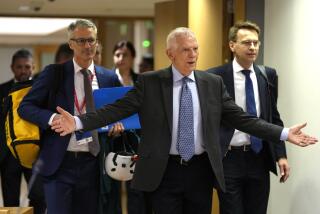East Europe Development Bank Talks Continue : Economics: A key dispute centers on how much the new institution should be able to lend the Soviet Union.
- Share via
PARIS — Officials of the 42 countries involved in creating the new East European development bank will make another attempt to resolve their differences today, but it was not immediately clear whether they can reach a compromise.
Although the group is expected to negotiate away some of the outstanding issues facing the new institution, officials say it still is uncertain whether the United States can settle a dispute with Western Europe over how much the new bank should be allowed to lend to the Soviet Union.
The United States fears that unless lending to the Soviet Union is limited, Moscow may swamp the new bank with demands for cash, draining off resources intended for countries such as Poland, Hungary and Czechoslovakia. Washington has warned it may pull out of the deal if the issue is not resolved.
The bank, known as the European Bank for Reconstruction and Development, will be designed to help the emerging East European democracies--and the Soviet Union--finance the building of new infrastructure and move toward market-oriented economic systems.
The session today will be the second plenary meeting that the 42 countries have had this year in their efforts to get the new institution off the ground. Besides the United States, participants include Japan, the Soviet Union, Australia, Canada and most of Western and Eastern Europe.
High-level representatives of the United States, Japan and the major West European powers held preliminary sessions on Sunday in hopes of working out compromises on some of the issues still outstanding. The group plans to meet again later this spring.
On the Soviet lending issue, the United States wants to limit any borrowing by Moscow to the actual hard-cash share that the Soviet Union contributes to the new bank--about $238 million under current proposals--for at least the first five years that the new institution is in place.
Washington also wants the money to go entirely to help create a Soviet private sector. And it wants the charter of the fledgling institution to prohibit any change in these rules without the approval of 85% of the new bank’s shareholders--effectively giving veto power to the United States and Japan.
But West European governments, which favor more generous help for the Soviet Union, are reluctant to go quite that far.
The United States is expected to hold about 10% of the voting power in the new bank and contribute about 10% of the institution’s projected $12 billion in total lending resources. The Europeans will hold 51%, the Soviet Union 6% and Japan 5%.
More to Read
Sign up for Essential California
The most important California stories and recommendations in your inbox every morning.
You may occasionally receive promotional content from the Los Angeles Times.













